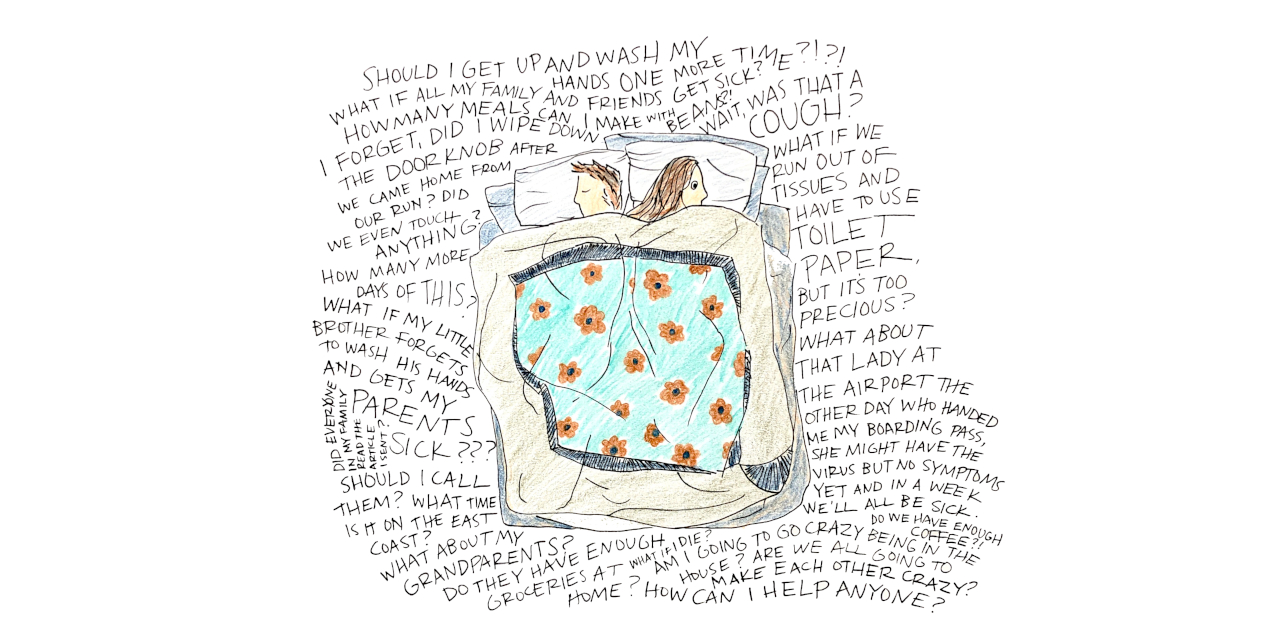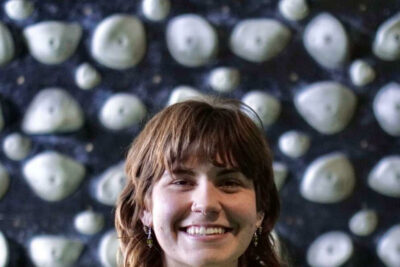After several nights of coronavirus-related insomnia, Anna Trella Ruth brought The Quaranzine to life.
Ruth, who finds inspiration in the pairing of art and the written word, found herself both sleep-deprived and curious about how people were spending their time and what they were feeling or thinking as the world was shutting down back in March.“I often make art in reaction to stress and change,” Ruth said. “One morning after several nights of very little sleep I drew a little comic … I thought I might post it on Instagram, where I share a lot of my work … I realized that maybe, if I started a new account, others would want to join and contribute, too, and perhaps Instagram could be a good way to make a virtual, collaborative zine.”
Ruth, unemployed at the time, and her housemates, all 2012 GC alumni, spent time brainstorming topics for a communal zine project. They pondered themes of cooking, playing, reading.
“I was really interested in running with the idea but still felt pretty directionless at that point, so I just let it simmer,” she said.
Ruth describes zines as an alternative format stemming from various subcultures.
“In this case, everyone is at once part of the same bizarre subculture and the virtual zine is a format that works in this moment of social distance,” she said.
“I have friends who are artists and I’ve seen their work in zines, and, as both a visual artist and a writer myself, I’ve generally been aware and interested because of the flexible capacity of zines to house a variety of mediums,” she said.
Seven months later and Ruth’s Instagram account, @the_quaranzine, has 1,463 followers and 288 posts.
Contributions have been made from users all around the world, including several from increasingly high-profile artists such as Malaka Gharib, deputy editor and digital strategist on NPR’s global health and development team.
Gharib published her own story told through graphics in 2019 titled I Was Their American Dream: A Graphic Memoir.
Only two criteria were placed on submissions: that it must be original work and that it should say something about one’s experience with and/or during COVID-19.
“What began as a fun little project three months ago quickly became fuel for my creativity, companionship in my fear and a balm to my anxious thought …” Ruth said.
One contributor to the project was Ruth’s English professor while a student at Goshen College: Jessica Baldanzi.
“When Anna started posting the Quaranzine, if it wasn’t literally a life-saver, it was certainly a sanity-saver,” Baldanzi said. “To see so many artists from all over the U.S. and the world posting so many different types of responses to the fear and anxiety of that moment was so therapeutic and full of hope.”
“In that moment … it felt like we were all pulling together collectively to try to make sense of a historical moment that didn’t yet make any sense at all,” she said.
Baldanzi submitted a piece titled, “Far Away, So Close: A Pandemic Journal of ‘Shelter in Place.’”
A quick scroll through The Quaranzine account and one will see representation of every imaginable emotion – an honest grappling with the realities of COVID-19.
“If you feel hopeless, that’s okay. What matters is the work your hands do,” said Valarie Kaur from Portland, Oregon. The words are presented over an image of sketched hands.
“Don’t worry. My white privilege should be enough,” wrote Jim Strouse from New York City, New York. In his sketch, a white man with a Trader Joe’s bag declines to wear a mask and gloves being offered to him.
“Take a yawn break. Let a tear pop out,” said Kat Sinrapee from Bangkok, Thailand.
Twenty-two Goshen College students and alumni also contributed to the project.
“This community of artists and supporters from around the world made this small corner of Instagram into what it is,” Ruth said in a post on her Instagram account.
“We’ve given each other moments of levity and grave reflection; invitations to both laugh and listen. Our stories are interesting and valuable individually, but they become something even more extraordinary together.”
But the page has stood silent since Ruth’s last post on June 10, which acknowledged forces at work in the world “that are much bigger, scarier and deadlier than COVID-19,” Ruth said.
“I think The Quaranzine was ready for a collective inhale-exhale in June,” she said. “After George Floyd was killed, I started getting fewer submissions and those that did come in weren’t relevant to what felt like a new and urgent social/political moment.”
For now, Ruth honors the collectiveness of the project and has invited conversation and response to her questions.
“The year has continued to unfold since then, and of course there would be entirely new things to say by now,” she said. “I’m still not sure what comes next.”
The questions she posed in her very first comic on The Quaranzine page on March 16 still stand: Should I get up and wash my hands one more time? What if all my friends and family get sick? Wait, was that a cough? Are we going to make each other crazy? How can I help anyone?
But it’s clear that Ruth’s artistic vision has already helped numbers of creative minds find their voice during the initial months of the pandemic.
“We may not be picking up a physical zine, but we can still page (ahem, scroll) through creative expressions of a common experience told by voices very different from our own,” she said. “In a whirlwind year of fear, tragedy, confusion and loss, I look to art to help me understand—and then reimagine—the world.”


